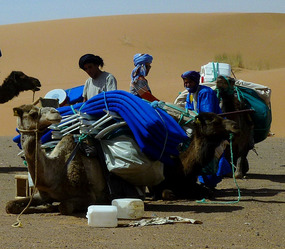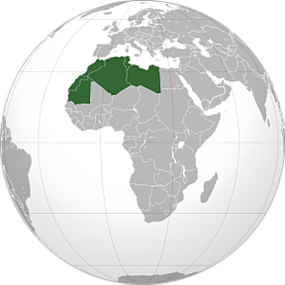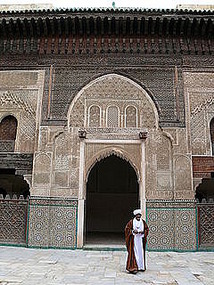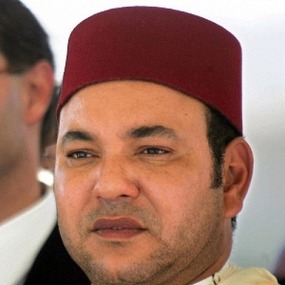As for the Sicily and Tunisia entries, I am including a brief timeline for Morocco to facilitate a better understanding of the rich historical fabric of the country and an enhanced understanding the cultures of the Moroccan peoples of today.
Moroccan ancient history shares many parallels with its neighbouring Mediterranean countries whose borders have merged and de-merged over the centuries. The Berbers however, with their feisty battles for power and retention of their cultural identity distinguish the Moroccan history from the eastern regions of the Mediterranean and north-eastern Africa. And today, the Berbers remain a fiercely proud people whose identity is broader than language and ethnicity, and encompasses the entire history of northern Africa.
TIMELINE
CIRCA 10,000 BC
The Berbers inhabit The Maghreb or western region of north Africa.
8TH - 6TH CENTURY BC
Phoenician colonisation of the Moroccan Coast.
5TH - 3RD CENTURY BC
The State of Carthage extends its power to the coastal areas of north-west Africa. Indigenous monarchs however continue to rule the hinterland.
3RD CENTURY BC - 40 BC
Indigenous Berber monarchs rule the entire Moroccan territory.
40 BC
Morocco is annexed to the Roman Empire.
430 - 700 AD
The Vandals invade and occupy Morocco. Later, Morocco becomes part of the Byzantine Empire. The Berbers however rule most of the high mountains areas in the hinterland.
700 AD
The Arab invasion and Muslim conquest of the Maghreb. The Arabs convert the indigenous population of Berbers to Islam but Berbers retain their customary laws.
739 - 743 AD
Berber revolt. Arab control ceases and Morocco fragments into a number of small independent Berber states. Berbers begin to shape their own version of Islam and for the next centuries Berber warlords rule Morocco.
789 - 974 AD
Moroccan Berber Idris ibn Abdallah founds the Idrisid Dynasty.
900 - 1060 AD
Rule of the Fatimids, Umayyads and Zenata Berber warlords.
1060 - 1549 AD
Rule of the Berber dynasties of the Almoravids, Almohads, Marinids and Wattasids. Unification of Morocco.
1549 AD
Rule of the Berber Sharifian dynasties of the Saadi and the Alaouite. The Alaouites retain power from the 17th century until 1912 when Morocco is divided into French and Spanish protectorates. Note: the current Moroccan royal family belong to the former Alaouite dynasty.
1860
Morocco disputes the Spanish enclave of Ceuta*. Spain declares war and wins a further enclave and an enlarged Ceuta enclave.
1884
Spain creates a protectorate in the coastal areas of Morocco.
1912
Morocco becomes a French protectorate under the Treaty of Fes. Under a second treaty signed by Spain and France, Spain is granted a Zone of Influence in the northern coastal regions and the country is divided between French and Spanish protectorates. The sultan retains only a figurehead role.
1921 - 1956
Tribal rebellions and strong opposition to French and Spanish rule. The Istiqlal Party is founded in 1943 to press for independence.
1956
Moroccan independence. Spain retains its two coastal enclaves of Ceuta and Melilla. Sultan Mohammad becomes King in 1957.
1961 - 1963
Death of King Mohammed in 1961 and Hassan II becomes the King of Morocco. The first general elections are held in 1963.
1974 - 1991
Western Sahara conflict. In 1974 Spain cedes the administration of Western Sahara to Morocco and Mauritania. Algeria objects, resulting in years of unrest and conflict.
1991
UN monitored ceasefire begins in Western Sahara but the situation remains undecided. Today, relations remain strained between Morocco and Algeria, Spain, and other Arab Maghreb Union nations of Libya, Mauritania and Tunisia over sovereignty of Western Sahara.
1999
King Hassan II is succeeded by his son Mohammed VI. A popular and more liberal leader, Mohammed VI enacts reforms to modernise the country and improve the human rights of the peoples of Morocco. Morocco retains strong ties to the West.
2011
Arab Spring demonstrations spread across a number of major cities in Morocco eventually resulting in King Mohammed VI reforming the constitution.
2011 - 2015
King Mohammed VI remains the ultimate arbiter of power. He remains popular and continues to guide overall policy whilst promoting modest political and economic reforms. Morocco continues to retain strong ties to Europe and the West.
* The two enclaves of Ceuta and Mellila have been under Spanish control for more than 400 years and remain so today. Located on the African side of the strait of Gibraltar, the cities having offered protection for Spanish ships and provided posts for trading between Europe and Africa. The Moroccans have long contested the ownership of Ceuta and Melilla (and a number of nearby Spanish islands) but the Spanish have refused to give ground. Today the enclaves are home of about 65,000 people in each city. Both are very poor with high unemployment rates. Moroccan labourers enter the enclaves each day but the cities also serve as relatively easy entry points for drug smugglers and African migrant hoping to enter Europe. There is little prospect of resolution of the ownership of these enclaves in the near future.
** Selected photos courtesy of Wikipedia
Morocco Profile: Ancient Berbers - The Arab Spring
Thursday, May 15, 2014
 Fes, Fès-Boulemane, Morocco
Fes, Fès-Boulemane, Morocco
Other Entries
-
6Under the Spell of Mt Etna
May 0510 days prior Catania, Italyphoto_camera31videocam 0comment 0
Catania, Italyphoto_camera31videocam 0comment 0 -
7Historic Neapolis OR "A Body Floats in a Fluid..."
May 069 days prior Syracuse, Italyphoto_camera11videocam 0comment 0
Syracuse, Italyphoto_camera11videocam 0comment 0 -
8Idyllic Ortygia: Of Legends and Nymphs
May 069 days prior Syracuse, Italyphoto_camera7videocam 0comment 0
Syracuse, Italyphoto_camera7videocam 0comment 0 -
9Images of Gorgeous Ortygia
May 078 days prior Ortygia, Italyphoto_camera15videocam 0comment 0
Ortygia, Italyphoto_camera15videocam 0comment 0 -
10"And the Mountains Danced As If Drunk......"
May 078 days prior Agrigento, Italyphoto_camera19videocam 0comment 0
Agrigento, Italyphoto_camera19videocam 0comment 0 -
11"Akragas - Most Beautiful City Mortals Ever Built"
May 087 days prior Agrigento, Italyphoto_camera16videocam 0comment 0
Agrigento, Italyphoto_camera16videocam 0comment 0 -
12A Quaint Little B & B Called the Antichi Catoi
May 087 days prior Agrigento, Italyphoto_camera8videocam 0comment 0
Agrigento, Italyphoto_camera8videocam 0comment 0 -
13Agrigento to Palermo - The Sicilian Way.......
May 096 days prior Palermo, Italyphoto_camera8videocam 0comment 0
Palermo, Italyphoto_camera8videocam 0comment 0 -
14Photo Album of The Magnificent Grand Hotel Igiea
May 096 days prior Palermo, Italyphoto_camera8videocam 0comment 0
Palermo, Italyphoto_camera8videocam 0comment 0 -
15Palermo: A Quilted History, A Fusion of Cultures
May 096 days prior Palermo, Italyphoto_camera24videocam 0comment 0
Palermo, Italyphoto_camera24videocam 0comment 0 -
16Treasures of the Conca D'Oro: Monreale & Cefalu
May 096 days prior Palermo, Italyphoto_camera16videocam 0comment 0
Palermo, Italyphoto_camera16videocam 0comment 0 -
17Farewell Sicily OR A Shaky Flight to Tunisia.
May 105 days prior Tunis, Tunisiaphoto_camera5videocam 0comment 0
Tunis, Tunisiaphoto_camera5videocam 0comment 0 -
18Tunisia Profile: Phoenicians to the Arab Spring
May 114 days prior Tunis, Tunisiaphoto_camera5videocam 0comment 0
Tunis, Tunisiaphoto_camera5videocam 0comment 0 -
19Tunis: A City of Brilliant White & Cobalt Blue
May 114 days prior Tunis, Tunisiaphoto_camera21videocam 0comment 0
Tunis, Tunisiaphoto_camera21videocam 0comment 0 -
20Toward the Algerian Border: Destination Le Kef
May 123 days prior Tunis, Tunisiaphoto_camera48videocam 0comment 0
Tunis, Tunisiaphoto_camera48videocam 0comment 0 -
21Tunis: Medinas, Mosques, Cafes & Razor Wire
May 132 days prior Tunis, Tunisiaphoto_camera10videocam 0comment 0
Tunis, Tunisiaphoto_camera10videocam 0comment 0 -
22"If You Love Ladakh, You Will Just ADORE Morocco!"
May 141 day prior Casablanca, Moroccophoto_camera18videocam 0comment 0
Casablanca, Moroccophoto_camera18videocam 0comment 0 -
23Morocco Profile: Ancient Berbers - The Arab Spring
May 15 Fes, Moroccophoto_camera4videocam 0comment 0
Fes, Moroccophoto_camera4videocam 0comment 0 -
24Meknes & Volubilis: The Beautiful People Go to Fes
May 15later that day Fes, Moroccophoto_camera25videocam 0comment 0
Fes, Moroccophoto_camera25videocam 0comment 0 -
25Fes: At Last Macke's Medina and the Elusive Donkey
May 161 day later Fes, Moroccophoto_camera29videocam 0comment 0
Fes, Moroccophoto_camera29videocam 0comment 0 -
26Across the Atlas: Auguste Macke's Mann mit Esel"!!
May 172 days later Midelt, Moroccophoto_camera25videocam 0comment 0
Midelt, Moroccophoto_camera25videocam 0comment 0 -
27Tribulations of the Trilobites
May 183 days later Midelt, Moroccophoto_camera12videocam 0comment 0
Midelt, Moroccophoto_camera12videocam 0comment 0 -
28Over the High Atlas: The Camel Man and The Storm
May 183 days later Tinghir, Moroccophoto_camera45videocam 0comment 0
Tinghir, Moroccophoto_camera45videocam 0comment 0 -
29A Smashing Start: How Often Does the Sahara Flood?
May 194 days later Merzouga, Moroccophoto_camera33videocam 0comment 0
Merzouga, Moroccophoto_camera33videocam 0comment 0 -
30Happy in the Sahara: Desert Foxes & Fossils
May 205 days later Merzouga, Moroccophoto_camera28videocam 0comment 0
Merzouga, Moroccophoto_camera28videocam 0comment 0 -
31Ouzina - A Desert Town With No Streets
May 216 days later Ouzina, Moroccophoto_camera23videocam 0comment 1
Ouzina, Moroccophoto_camera23videocam 0comment 1 -
32To Zagora: Deserts, Floods and Hostile Borders
May 227 days later Zagora, Moroccophoto_camera22videocam 0comment 0
Zagora, Moroccophoto_camera22videocam 0comment 0 -
33A Day Around Zagora OR Just Hamadu and Me
May 238 days later Ouarzazate, Moroccophoto_camera19videocam 0comment 0
Ouarzazate, Moroccophoto_camera19videocam 0comment 0 -
34Ouarzazate: Lawrence of Arabia and More......
May 249 days later Tizi-n-Tichka, Moroccophoto_camera26videocam 0comment 0
Tizi-n-Tichka, Moroccophoto_camera26videocam 0comment 0 -
35Where the Sun Sets OR a Brush with a Cobra!
May 2510 days later Marrakech, Moroccophoto_camera12videocam 0comment 0
Marrakech, Moroccophoto_camera12videocam 0comment 0 -
36Finding FedEx Freight For Our Fragile Fossils
May 2611 days later Rome, Italyphoto_camera6videocam 0comment 0
Rome, Italyphoto_camera6videocam 0comment 0 -
37Palatine: Foundations of the Eternal City of Rome
May 2712 days later Rome, Italyphoto_camera24videocam 0comment 0
Rome, Italyphoto_camera24videocam 0comment 0 -
38Perfect Day in Rome: Tartufo, Piazzas & Basilicas
May 2813 days later Rome, Italyphoto_camera25videocam 0comment 0
Rome, Italyphoto_camera25videocam 0comment 0 -
39Vatican City: The Smallest State in the World
May 2914 days later Rome, Italyphoto_camera25videocam 0comment 0
Rome, Italyphoto_camera25videocam 0comment 0 -
40Heading Home - Shanghai & The Toabao Markets
May 3015 days later Shanghai, Chinaphoto_camera10videocam 0comment 0
Shanghai, Chinaphoto_camera10videocam 0comment 0 -
41Homeward Bound to Australia & Epilogue
Jun 0218 days later Crowdy Head, Australiaphoto_camera2videocam 0comment 0
Crowdy Head, Australiaphoto_camera2videocam 0comment 0

 Fes, Fès-Boulemane, Morocco
Fes, Fès-Boulemane, Morocco








2025-05-22